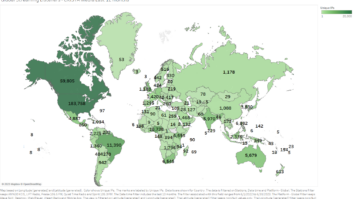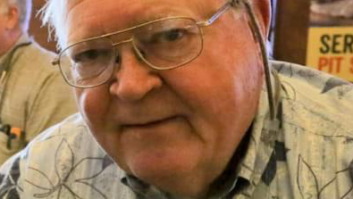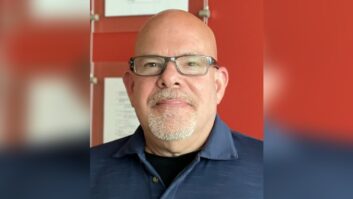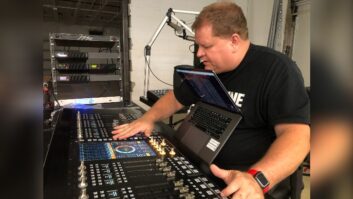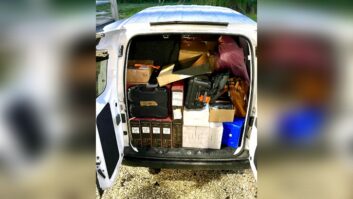The author writes in his capacity with the Society of Broadcast Engineers.
The SBE Ennes Educational Series presents two types of live, full-day programs each year.
One is a traveling “road show.” We’ve had them recently in Sacramento and Miami, and more are planned soon in Pittsburgh and New York.
For the 16th year, SBE also will present a full-day Ennes program at the National Association of Broadcasters spring show in Las Vegas.

In the SBE booth, Executive Director John Poray, right, visits with Mark Persons, CPBE, a Radio World contributor. The program, Saturday, April 9, is in conjunction with the Public Broadcasting Service. PBS/NPR programs start Wednesday prior to NAB; on Saturday those events join up with the SBE Ennes program, which is in turn part of the NAB Broadcast Engineering Conference.
The annual Ennes program at NAB is unique in that it is driven by the simple question, “What is it broadcast engineers most need to know this year?”
Review the program topics over the years and you’ll receive a lesson in the history of technology driving our industry. In other years the program leaned toward deep-dives into basics. Years six and seven were focused on IT and the new Certified Broadcast Networking Technologist certification from SBE. Other years we looked at “everything” RF or audio.
Up time
This is the first year that the dominant driving force has been not technology but economic reality.
Whether dealing with receivership, tight budgets or changing programming and ever-tighter workflows, most of us are focused more than ever on infrastructure.
One of the things that make broadcast engineering such a broad-ranging field is that we have incredible infrastructure to maintain and manage. From buildings, to generators, to studios, to NOCs and data centers, to towers in the clouds, few occupations demand such a wide skill set … and that’s before we mention broadcast skills.
As has been tradition, we start the day at 8 a.m. with a two-hour, back-to-basics tutorial.
Ronald Eligator of Acoustic Dimensions, Arthur Metzler of AMA Consulting Engineers, Neil Tucker of Design Republic and Stuart Reynolds of Diversified Systems provide a comprehensive seminar on designing, building and maintaining broadcast infrastructures, with an emphasis on dealing with the specialists and specialties involved, and most important the management of the projects and meeting time-lines and budgets.
SBE General Counsel Chris Imlay, CBT, of Freret, Imlay & Tepper then addresses legal aspects of engineering that arise when a company is in bankruptcy and operating under business rules that are considerably different than “normal.” Imlay knows broadcast engineers and what we deal with better than almost anyone in the legal field.
Well known in these pages is Tieline Technology’s John Bisset, who writes Radio World’s Workbench column and is an expert in practical tips and tricks that cross all aspects of infrastructure. We asked John to do a “best of” ideas session to help you maintain “up time” cost-effectively.
Brad Strommen of Comcast Entertainment Group has spent the last few years assembling large monitoring and control systems, so who better to bring us up to speed with the state of the art in monitoring and control functions, which are ever more critical?
After lunch, in what is probably the best-titled session, we have “IT Infrastructure and the Accidental Administrator.” Brad Gilmer did a piece, a little off-topic, on the practical realities of being a broadcast engineer in an information systems-based business. How does that redefine not just what we need to know and be proficient with, but how we work with others and structure our departments? This is something we think about a lot, but seldom discuss.
Dave Davies of Consolidated Engineering Inc. has been on the Ennes road show program for the last year, as has Skip Erickson of Harris. This isn’t the first time we’ve asked someone doing the road show to put together a special program for NAB.
In the case of Davies, it’s about towers and what it takes to manage and maintain them intelligently. He’ll talk about the “three Cs” of structural failure: causes, cost and cures. (On Friday, the PBS program has him covering more of the physical aspects of towers.)
In the case of Erickson, it’s about disaster and the realities of recovering from the loss of your infrastructure, in a presentation titled “KREX: The Real World of Disaster Recovery.”
We’re talking minions, credit cards and the politics of coffee, crime scenes, regulations and real estate. In other words, these two presentations are anything but academic.
Power is always a critical need. William Havrilla of Bay City Electric Works will take us through the process of giving our power systems their maximum life and reliability. As power systems become more intelligent, we have more opportunity to know the health of our systems and exercise and maintenance routines.
Texas A&M’s Wayne M. Pecena, CPBE, 8-VSB, AMD, DRB, CBNT, has agreed to close out the day with a presentation about something broadcast engineers definitely need to be aware of: the transition to IPv6.
Maintaining our IT infrastructure means facing IPv6. As much fun as NATs are, the limitations of IPv4 addressing, from QOS, to multicast, to maintaining IPsec from end to end, are pushing our infrastructure to the limits. Twelve years into the standards track and by NAB time, the last top-level block of IPv4 addresses will have been released. IPv6 is widely adopted on commercial networks and moving closer.
Attendance requires full NAB registration or PBS/NPR program access. SBE members receive the rate of $595 by registering using the special NAB Partner rate. Registrations can be made at www.nabshow.com.
Come to the booth
In addition to the Ennes Workshop, SBE will have a booth and hold several meetings and events at NAB.
On Saturday are the Frequency Coordination Committee Meeting (closed) and Certification Committee Meeting (partially closed). On Sunday the society’s board of directors meets, as does the Education Committee. Tuesday brings certification exams and a frequency coordinators’ meeting; Wednesday is SBE’s EAS meeting.
A highlight will be the spring Membership Meeting on Tuesday, April 12 at 5 p.m. We will recognize a number of local chapter certification chairs for service and three Sustaining Member companies for having been members of the SBE for 25 years. Prizes will be given away to several winners.
The society’s booth will be on the second floor concourse of the Las Vegas Convention Center South Hall, Lobby Booth 29. The location is up the escalator from the South Hall main entrance and just outside the entry to the exhibits on the second floor, as in recent years. BEC technical sessions will be nearby in the South Hall second-floor meeting rooms.
The booth will offer SBE-published handbooks, technical books from major publishers and the SBE CertPreview. There also will be several society logo items for sale. Membership renewals and new memberships may be transacted at the booth. Staff and national board members will be there to answer questions about membership, certification, educational programs and regulatory issues. Booth hours are Sunday from 2 to 4 p.m. and then generally tracking exhibit floor hours the rest of the week.
Fred Baumgartner, CPBE, CBNT, is with the Ennes Educational Foundation Trust and Harris Broadcast.
The print version of this article gave the wrong title for John Poray in the caption; he is executive director of SBE.







